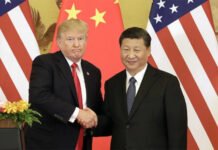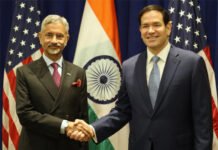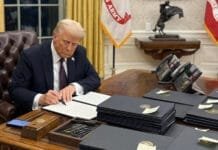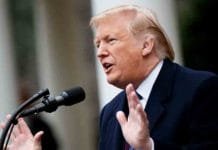In a significant development in global trade diplomacy, U.S. President Donald Trump has announced that the United States is very close to finalizing a bilateral trade agreement with India. This announcement coincides with a sweeping tariff crackdown on 14 countries, with duties ranging from 25% to 40%, underscoring a renewed protectionist stance by the U.S. administration.
Trump Signals Breakthrough in India-US Trade Talks
Speaking at a press event, Trump emphasized the advanced stage of negotiations with India, describing it as “very close.” He cited successful deals already secured with the United Kingdom and China, and contrasted that with ongoing impasses involving other nations. According to him, the U.S. is now sending formal notices to countries failing to meet trade expectations, informing them of the tariffs they will incur.
“We are not being unfair,” Trump said. “Some nations might make adjustments, others won’t. It depends on whether they have a legitimate case.”
Tariffs Slam 14 Nations as Deadline Nears
Trump’s tariff announcement, effective August 1, targets countries allegedly contributing to America’s trade deficit. This includes strategic partners like Japan and South Korea, along with emerging economies. Here’s a breakdown of the newly imposed tariffs:
| Country | Tariff (%) |
|---|---|
| Bangladesh | 35% |
| Bosnia and Herzegovina | 30% |
| Cambodia | 36% |
| Indonesia | 32% |
| Japan | 25% |
| Kazakhstan | 25% |
| Laos | 40% |
| Malaysia | 25% |
| Myanmar | 40% |
| Serbia | 35% |
| Tunisia | 25% |
| South Africa | 30% |
| South Korea | 25% |
| Thailand | 36% |
These tariffs are part of a wider retaliatory strategy initiated on April 2, when a blanket 10% baseline tariff was introduced for all countries. India was initially hit with a 26% tariff, but it was postponed for 90 days, with a deadline ending July 9, allowing time to reach a compromise.
India Pushes for Full Tariff Waiver
India, seeking a complete exemption from the 26% tariff, has intensified efforts to reach a preliminary deal ahead of the formal agreement deadline set for September-October 2025. This interim understanding could help avoid punitive U.S. tariffs, which remain a critical concern for Indian steel, aluminium, and automobile exporters.
Indian Commerce Minister Piyush Goyal has reiterated that national interest remains non-negotiable. “We will not be bound by any artificial timeline. A deal must be fair, complete, and beneficial to India,” Goyal said on July 4.
Agriculture and Dairy Sectors: The Unyielding Red Lines
A major sticking point remains India’s refusal to open its agriculture and dairy sectors—a stance it has consistently maintained across all trade deals globally. U.S. negotiators have been pressing for greater access for American products in these sectors, but India has remained firm, citing the livelihood of millions of farmers and the political sensitivity surrounding these industries.
The Indian negotiating team, which visited Washington recently, has returned with no breakthrough on this front. Sources close to the talks report a deadlock over U.S. demands for tariff relaxations on agricultural and dairy imports.
Steel, Aluminium, and Auto Exports: High-Stakes Sectors
Tariffs on steel (up to 50%), aluminium, and automobiles (25%) are causing major alarm among Indian exporters. These sectors represent multi-billion-dollar annual trade flows, and any U.S. restrictions could significantly impact India’s industrial output and employment.
India has been seeking a gradual tariff rollback, especially in light of global steel demand recovering post-pandemic. However, Washington remains firm on applying pressure to ensure reciprocal trade access.
US Tariff Deadline Looms: July 9 Critical for India
With Trump’s 90-day tariff postponement expiring on July 9, India’s trade negotiators face a narrow window to secure relief. Failure to reach a partial agreement may trigger the full 26% tariff on Indian exports, further straining an already complex relationship.
Sources indicate that backchannel talks are ongoing, with both sides exploring creative solutions to protect strategic sectors while pushing forward on broader trade objectives.
US Ready to Reconsider if Countries Cooperate
When asked whether the August 1 tariff implementation was final, Trump said, “Yes, I am firm—but not 100 percent firm.” He indicated openness to revising tariffs if affected countries engage in constructive negotiations.
This comment has sparked cautious optimism in New Delhi. Officials see it as an opportunity to negotiate relief ahead of the July 9 deadline. However, they stress that any final deal must align with India’s core economic interests.
India’s Trade Strategy: Balancing Growth and Protection
India’s trade policy under Prime Minister Narendra Modi remains focused on strategic autonomy. While India is open to deeper integration with the global economy, it has consistently protected domestic industries from foreign competition in sensitive areas.
The ongoing U.S. talks reflect this approach—seeking concessions on industrial exports while safeguarding rural livelihoods. India has also pursued parallel trade talks with the European Union, Australia, and the Gulf Cooperation Council (GCC), aiming to diversify its economic partnerships.
BRICS Tariff Threat: Rising Global Trade Tensions
In a related move, Trump has warned of an additional 10% tariff on BRICS countries, a group including Brazil, Russia, India, China, and South Africa. This escalation, if realized, could intensify trade tensions and create ripple effects across global markets.
India has not officially responded to this threat, but analysts believe it will further complicate trade negotiations and may push New Delhi toward stronger regional cooperation with Asia-Pacific and African economies.
Outlook: A Race Against the Clock
With the India-US trade deal hanging in the balance, the coming days are pivotal. Both sides stand to gain from a mutually beneficial agreement—but the road ahead remains fraught with challenges.
India’s firm stand on agriculture, the looming tariff deadline, and broader geopolitical uncertainties all contribute to a high-stakes negotiation. The outcome will not only determine the future of India-US trade relations but will also set a precedent for global trade policy under emerging political leadership.
If a deal is struck, it could mark a milestone in economic cooperation between the world’s largest democracies. If talks falter, both economies may retreat into protectionist postures, risking a deeper trade divide.
















